Last updated: May 24, 2017
Article
Glacier Bay’s Underwater Sound Environment: The Effects of Cruise Ship Noise on Humpback Whale Habitat
By Christine M. Gabriele, Christopher W. Clark, Adam S. Frankel, and Blair Kipple
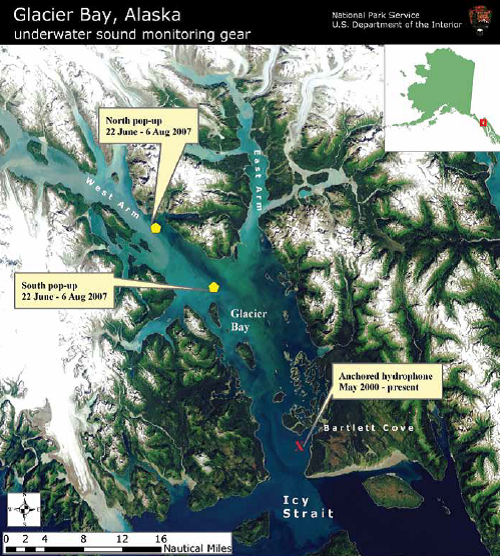
(a) Since May 2000, a hydrophone anchored to the seafloor has allowed continuous monitoring of underwater sounds.
Introduction
When you see a cruise ship floating majestically through the waters of Glacier Bay, it seems almost silent. But if you were a marine mammal underwater, you would hear a very different scene. Long before you could see the ship, you would hear the steady rumble of diesel-electric generators and the low-frequency drumming of its massive propellers pushing the ship forward. This cacophony would become louder until it dominated your acoustic sense, reducing your ability to hear other important sounds such as the school of fish you were hunting, or the killer whales that might be hunting you. You might not be able to tell exactly where the ship was located, to avoid getting struck by it. Calling to communicate with others would be useless with this level of noise. Eventually the dense cloud of ship noise would begin to ebb as the ship moved away, finally receding into the distance about an hour after you first started hearing it. Like the sun coming out from behind a cloud, the acoustic scene re-emerges and your acoustic habitat is yours again, but only until the noise from the next vessel appears on the horizon. Marine mammals that know and experience Glacier Bay through their ears undergo this kind of dynamic and reversible acoustic habitat loss many times every day.Although the scientific details of whale auditory perception are not known, we do know that they are acoustically adept and rely on sound for basic life functions such as feeding, finding mates, detecting predators and maintaining social bonds. Vessel noise can thus interfere with the daily activities of whales; however, almost all park visitors who come to see the whales in Glacier Bay National Park (GLBA) travel on cruise ships and other motorized vessels. To address this collision of the senses, GLBA is collaborating with acoustic experts to understand underwater noise and to look for ways to mitigate noise effects on the endangered humpback whales that spend their summers in park waters. GLBA is mandated to manage the number and behavior of cruise ships and other vessels in such a way as to minimize their effects on park resources. While quotas for private, charter and tour vessels have been set at levels defined in the Code of Federal Regulations enacted in 2006 (36 CFR 13, subpart N), GLBA is faced with defining cruise ship quotas on an annual basis, based on a variety of scientific and other information sources.
Here we describe three related avenues of inquiry that seek to quantify vessel-generated underwater sound and predict its effects on the acoustic habitat of humpback whales in GLBA. Large vessel traffic contributes substantial amounts of underwater noise into marine environments worldwide, but few other quantitative studies in marine protected areas have been attempted (Hatch et al. 2008). It is important to note that in addition to the numerous potential impacts of man-made noise on wildlife (Barber et al. 2009), the natural soundscape is gaining prominence as a park resource with its own intrinsic value (Fristrup et al. 2009). Underwater and airborne soundscapes are among GLBA’s ‘Vital Signs’ for the Inventory and Monitoring Program (see the Southeast Alaska Inventory and Monitoring Network website).
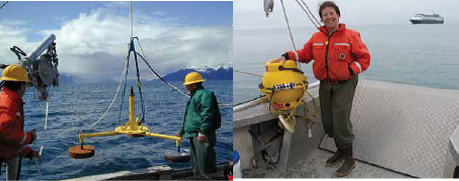
NPS Photos
Methods
Calibrated Measurements of Individual VesselsIn 1999, the park began its acoustic monitoring program in collaboration with the U.S. Navy by making calibrated measurements of cruise ship underwater sound at the Navy’s Southeast Alaska Acoustic Measurement Facility in Ketchikan, Alaska. So far, ten ships
have been measured at different travel speeds, with voluntary cooperation of cruise lines. These calibrated measurements, called “sound signatures” were among the world’s first quantitative descriptions of cruise ship sounds, giving us our first indication of the effect of ship speed on sound output (Kipple 2002). Between 2000 and 2009, we measured the sound signatures of 32 small vessels ranging from a 14 ft skiff to a 250 ft tour boat. Little previous sound signature data existed for small vessels. These sound signatures are an important data source for modeling noise exposures, described below, to predict the effects of vessel management options.
Collecting Ambient Noise Recordings
Since May 2000, GLBA has recorded and analyzed sounds near the entrance to Glacier Bay (Figure 1). We monitored underwater sound using a calibrated hydrophone anchored at 95 ft depth, connected by a submerged cable to a custom-built computer at park headquarters (Figure 1a). The computer displays a continuous real-time sound spectrogram and collects an automated 30-second sample every hour and records it in a database. Since 2005, the system has also collected continuous sound recordings. In 2007, GLBA collaborated with the Bioacoustics Research Program at Cornell University to place two marine autonomous acoustic recorders (pop-ups) in upper Glacier Bay to record 45 days of continuous acoustic data (Figure 1b). Both types of recordings enabled us to document and summarize the characteristics and preva-lence of natural and man-made sounds in Glacier Bay.
Modeling to Predict the Effects of Vessel Quotas and Speeds
We used the Acoustic Integration Model© (AIM), developed by Marine Acoustics Incorporated, to simulate whale and vessel movement through time and three dimensions of space (i.e., ocean volume) under 11 different scenarios by varying the number, speeds and arrival times of cruise ships and tour vessels as they moved among 1,000 simulated whales scattered throughout Glacier Bay (Frankel and Gabriele, submitted). Existing data on Glacier Bay bathymetry (Hooge et al. 2004), sound propagation (Malme et al. 1982) and humpback whale distribution (Neilson and Gabriele 2009) were incorporated into the model. The modeling effort focused specifi-cally on large vessels to provide information relevant to decisions on future changes in cruise ship numbers and operations, though smaller vessels are known to contribute significantly to underwater noise levels in the park (Kipple 2003, Kipple and Gabriele 2003b).
Cruise ship acoustic characteristics at 10 and 20 knot speeds were derived from calibrated measurements of four ships (Kipple 2002, 2004a, 2004b). Acoustic exposure, defined as the estimated quantity of sound that each simulated ‘whale’ received, was quantified with two metrics: maximum sound pressure level (MSPL) and the daily integrated sound exposure level (SEL). Using these and other raw materials, AIM computed the received sound level for each ‘whale’ every 30 seconds and compiled them into an acoustic exposure time history for each ‘whale’.
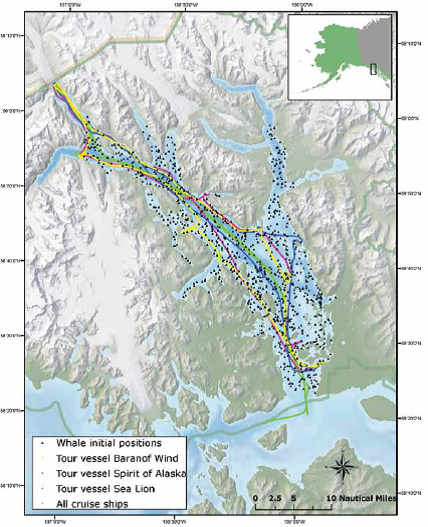
Figure 2. Ship Track and Whale Distribution in Acoustic Integration Model (AIM). One or two simulated cruise ships and three tour vessels of known underwater sound characteristics travelled through a Glacier Bay filled with 1,000 hypothetical whales. All runs used the same vessel tracks but ship speed (13 vs. 20 knots), numbers and arrival times varied, to estimate the effects of potential management decisions on whale noise exposure.
Key Results - Ambient Noise
-
The proportion of underwater sound samples that contained motor vessel noise increased from 51% in 2000-2002 to 59% in 2007-2008 overall for May through September (Figure 3). The 5% increase in cruise ships over time (mean 210 vs. 220 ships annually) likely explains some of this noise increase, but the approximately 100% increase in private vessel entries was almost certainly an even more important factor.
- Individual vessels are almost always quieter at slower speeds, and this likely explains why the underwater noise environment in Glacier Bay was substantially quieter when vessels were required to travel at 13 knots rather than at 20 knots (Kipple and Gabriele 2003b).
- Cruise ships are audible (> 3 decibels above natural background noise levels) for 40-74 minutes each time they enter or exit Glacier Bay as measured at the anchored hydrophone in the Lower Bay (Figure 5) (Clark 2007).
- Humpback whale song, a mating-related male display (with prolonged bouts in September through November), and male harbor seal territorial roaring (present in almost every hourly sample in June and July) were the most pervasive biological sounds detected. Simple humpback whale “whup” calls were the most common whale vocalization heard, probably functioning as contact calls among all age-sex classes of whales.
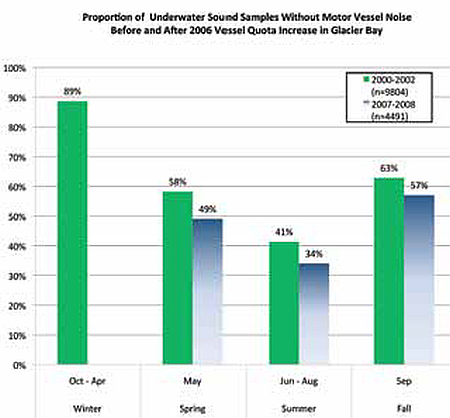
Figure 3. Hourly 30-sec samples of underwater sound were examined for the presence or absence of motor vessel noise, before and after the 2006 vessel quota increase. The propor-tion of samples containing vessel noise increased from 51% to 59% for May - September. Winter samples for 2007-2008 were not examined, to focus analysis effort on the main visitor season.
Key Results - AIM Model
- Cruise ship speed appeared to be the dominant factor in determining the noise levels to which whales were exposed. Median daily and maximal noise exposures in AIM runs with two slow cruise ships were lower than those with a single fast cruise ship (Figure 4).
- Although the slower, quieter 13-knot ships exposed whales to noise for a longer period of time, the faster, louder 20 knot ships produced significantly (F =1923.16, df =3, p <0.001) greater maximal and daily noise exposures. Although a 13 knot ship takes 1.5 times longer to pass by than a 20 knot ship, a listener would need to hear a slow ship approximately 7.5 times longer than a fast ship to experience the same noise exposure, (Frankel and Gabriele, submitted).
- Smaller tour vessels contributed substantially to underwater noise on days that are relatively quiet (i.e., days with one slow cruise ship), but on relatively noisy days (i.e., days with two fast cruise ships) tour vessel noise resulted in little additional noise exposure for whales.
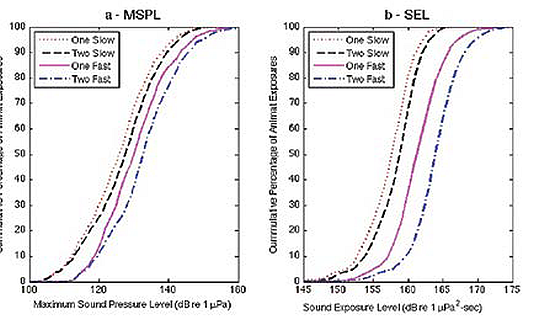
Figure 4. Cumulative probability functions for AIM simulations (a) MSPL = the single loudest sound level to which each hypothetical whale was exposed (b) SEL = the sum of all sound energy received by each hypothetical whale over the course of a day. Cruise ship speed was the dominant factor - runs with two slow ships were quieter than ones with one fast ship. Decibels use a logarithmic scale so differences in dB indicate large differences in magnitude. Doubling a sound’s amplitude produces a 6 dB SPL increase.
Next Steps and Reccomendations
Prior to this study, the natural underwater sound environment, the role of vessels, and the potential effects of noise on the acoustic environment of Glacier Bay were unknown. Through ambient noise monitoring, we demonstrated that increases in vessel traffic of all kinds resulted in a decrease in the availability of natural sound conditions at the mouth of Glacier Bay (Figure 3). We also documented that seals and whales frequently use the natural soundscape for their vocalizations (Kipple and Gabriele 2003b). We have also made the first steps toward predicting the effects of specific cruise ship management actions on the underwater acoustic habitat for different marine species that depend on this habitat seasonally or year-round. These findings provide a cornerstone for decisions about the management of cruise ships and other vessel traffic in the park, but the most challenging tasks still lie ahead.It is extremely difficult to assign a particular decibel level or proportion of time when the underwater sound environment is dominated by vessel noise (Figure 3) as the “acceptable” level of man-made noise to meet the NPS mandate to preserve natural habitats “unimpaired”. However, the difficult and ultimately subjective process of defining the desired future condition of Glacier Bay’s underwater acoustic environment is precisely what awaits park managers.

(Figure 6) (Clark et al. 2009). Data collection to describe acoustic conditions throughout Glacier Bay, a better understanding of marine mammal hearing, and continuing to obtain sound signatures from the ever-changing cruise ship fleet will provide an essential basis for such efforts.
In the meantime, the results from this study provide park managers with some guidance toward ongoing cruise ship management decisions. The AIM modeling indicates that slower vessel speed was one of the most effective ways to reduce cruise ship underwater sound impacts. The best available information also indicates that reducing vessel speed reduces the probability of whale mortalities resulting from collisions between vessels and whales (Laist et al. 2001, Vanderlaan and Taggart 2007), and studies are underway to empirically test this idea in and around Glacier Bay (Harris et al. this volume, Gende et al. this volume).
As terrestrial, vision-centric humans, it not easy for us to fully grasp the importance of the underwater sound environment as a key marine habitat characteristic, even if we conceptually understand that marine animals depend on what they hear to make their daily living. Fortunately, Glacier Bay is relatively quiet in comparison to industrialized parts of the ocean (Hatch et al. 2008, Clark et al. 2009), where there is concern that chronic noise influences individual life histories and may exert population level effects. Even in chronically noisy ocean habitats, direct biological impacts are not readily apparent and not often predictable. However, even in the absence of documented biological effects, natural sound environments have intrinsic value that warrant protection on an equal footing with other natural resources in national parks.
While industrialized underwater habitats will be very difficult to restore, national parks have a unique and profoundly important opportunity to preserve natural underwater sound environments and prevent the loss of acoustic habitat. If a marine protected area “should be a place that provides exceptional ecological protection for marine species” (Haren 2007) then acoustic habitat protection is an essential component of ecologically meaningful protection. Moreover, marine protected areas like Glacier Bay National Park and Preserve have a special role as natural laboratories that can foster an improved understanding of anthropogenic noise and creative approaches to reducing its effects on marine life.
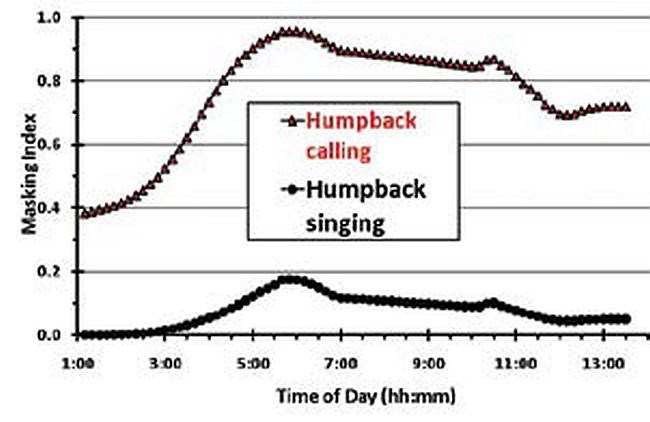
Figure 6. Effect of Vessel Noise Masking on Humpback Whale Vocalizations. Humpback whales are suspected to communicate at distances of at least 6.2 miles (10 km) in natural sound environments. Masking occurs when noise impedes a listener’s ability to under-stand, recognize or detect sounds of interest. The Masking Index shows the percentage change in a whale’s acoustic habitat caused by interfering noise. A humpback whale making a simple “whup” call loses more of its acoustic habitat (40-95%) than a singing humpback (< 20%) in the same noise conditions because song is louder, more repetitive and spans a wider frequency range, making it more detectable by other whales. Visit https://www.nps.gov/glba/naturescience/soundclips.htm to hear examples of whale and vessel sounds.
Acknowledgements
This study would not have been possible without the assistance of many Glacier Bay National Park and Preserve staff, data analysts at the Navy’s Naval Surface Warfare Center, and Russ Charif and Dimitri Ponirakis of the Bioacoustics Research Program at Cornell Laboratory of Ornithology’s Bioacoustics Research Program. We also thank Holland America, Princess, Norwegian, Crystal and World Explorer Cruise Lines for their participation in the sound signature measurements. Initial funding for ambient noise monitoring was provided by the National Park Service Fee Demonstration Program.References
Barber Jessie R., Kurt M. Fristrup, Casey L. Brown, Aman-da R. Hardy, Lisa M. Angeloni, and Kevin R. Crooks. 2009. Conserving the wild life therein: Protecting park fauna from anthropogenic noise. Park Science 26:26-31.Clark, C.W. 2007. Preliminary Data Analysis of Underwater Acoustic Monitoring of Glacier Bay National Park and Preserve. Bioacoustics Research Program, Cornell Laboratory of Ornithology.
Clark C.W., W.T. Ellison, B.L.Southall, L. Hatch S.M.V Parijs, A.S. Frankel and D. Ponirakis. 2009 Acoustic Masking in Marine Ecosystems: Intuitions, Analysis, and Implications. Marine Ecology Progress Series 395: 201-222.
Fristrup, Kurt M., D. Joyce, and E. Lynch. 2009. Measuring and monitoring soundscapes in the national parks. Park Science 26: 32-36.
Frankel, A. and C.M. Gabriele. submitted. Estimating the Acoustic Exposure of Humpback Whales to Cruise and Tour Vessels in Glacier Bay, Alaska. Environmental Management.
Harris, Karin, and Scott Gende. 2010. Cruise ship-humpback whale encounters in and around Glacier Bay National Park, Alaska. Alaska Park Science.
Gende, Scott, Karin Harris, and Julie Nielsen. 2010. Using observers to record encounters between cruise ships and humpback whales. Alaska Park Science.
Haren, A. 2007. Reducing Noise Pollution from Commercial Shipping the the Channel Islands National Marine Sanctuary: A Case Study in Marine Protected Area Management of Underwater Noise. Journal of International Wildlife Law and Policy 10: 153-179.
Hatch, L., C. Clark, R. Merrick, S. Van Parijs, D. Ponirakis, K. Schwehr, M. Thompson and D. Wiley. 2008. Characterizing the relative contributions of large vessels to total ocean noise fields: A case study using the Gerry E. Studds Stellwagen Bank National Marine Sanctuary. Environmental Management 42: 735-752.
Hooge, P.N., P.R. Carlson, J. Mondragon, L.L. Etherington and G.R. Cochrane. 2004. Seafloor habitat mapping and classification in Glacier Bay Alaska: Phase 1&2 1996-2004. U.S. Geological Survey, Alaska Science Center, Glacier Bay Field Station.
Kipple, B.M. 2002. Southeast Alaska cruise ship underwater acoustic noise: underwater acoustic signatures of six cruise ships that sail Southeast Alaska. Naval Surface Warfare Center - Detachment Bremerton. Report to National Park Service. Technical Report NSWCCD-71-TR-2002-574.
Kipple, B., and C. Gabriele. 2003a. Glacier Bay watercraft noise: underwater acoustic noise levels of watercraft operated by Glacier Bay National Park and Preserve as measured in 2000 and 2002. Naval Surface Warfare Center - Carderock Division. Report to National Park Service. Technical Report NSWCCD-71-TR-2003/522.
Kipple, B.M., and C.M. Gabriele. 2003b. Glacier Bay Underwater Noise - August 2000 through August 2002. Naval Surface Warfare Center - Carderock Division. Technical Report NSWCCD-71-TR-2004/521.
Kipple, B.M., and C.M. Gabriele. 2004. Glacier Bay watercraft noise - noise characterization for tour, charter, private and government vessels. Naval Surface Warfare Center. Technical Report. NSWCCD-71-TR-2004/545.
Kipple, B.M. 2004a. Volendam Underwater Acoustic Levels. Naval Surface Warfare Center, Bremerton Detachment.
Kipple, B.M. 2004b. Coral Princess Underwater Acoustic Levels. Naval Surface Warfare Center, Bremerton Detachment.
Neilson, J.L. and C.M. Gabriele 2009. Results of humpback whale population monitoring in Glacier Bay and adjacent waters: 2009. U.S. National Park Service, Glacier Bay National Park and Preserve. Annual Report.
Malme C.I., P.R. Miles, and P.T. McElroy 1982. The acoustic environment of humpback whales in Glacier Bay and Frederick Sound/Stephens Passage, Alaska. Bolt, Beranek and Newman. Report 4848.
Laist, D.W., A.R. Knowlton, J.G. Mead, A.S. Collet, and M. Podesta. 2001. Collisions between ships and whales. Marine Mammal Science 17(1): 35-75.
U.S. Federal Government. 36 CFR 13, subpart N (http://ecfr.gpoaccess.gov/cgi/t/text/text-idx?c=ecfr&rgn=div5&view=text&node=36:1.0.1.1.13&idno=36
Vanderlaan, A.S.M., and C.T. Taggart. 2007. Vessel collisions with whales: the probability of lethal injury based on vessel speed. Marine Mammal Science 23(1): 144-156.
